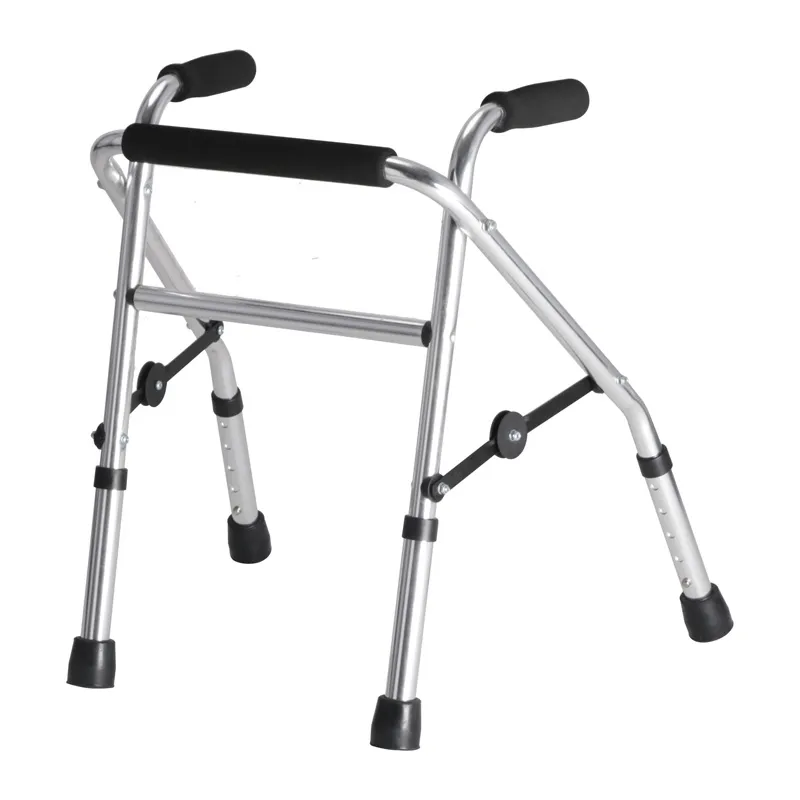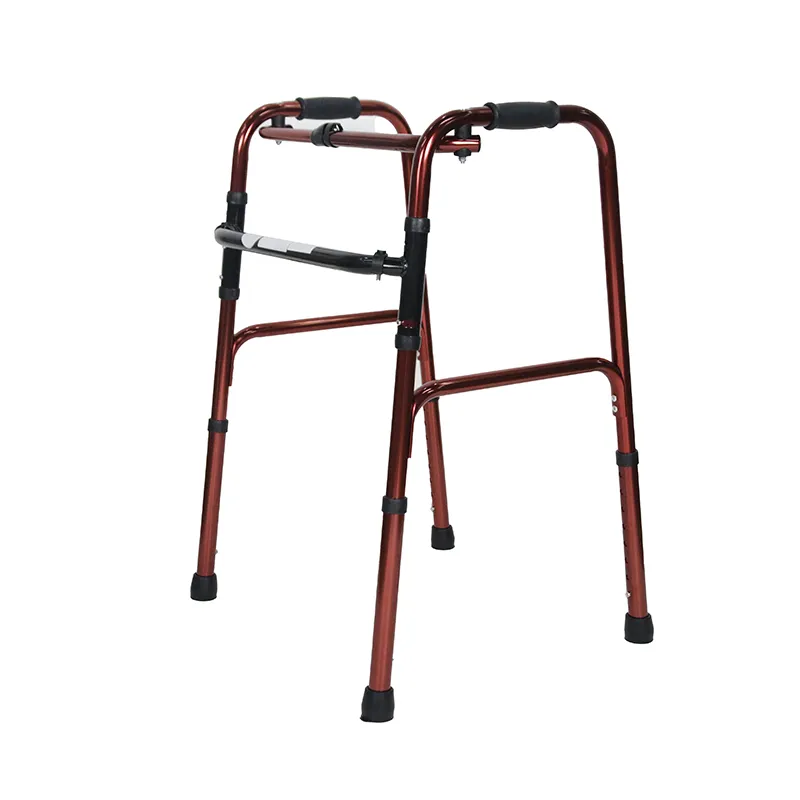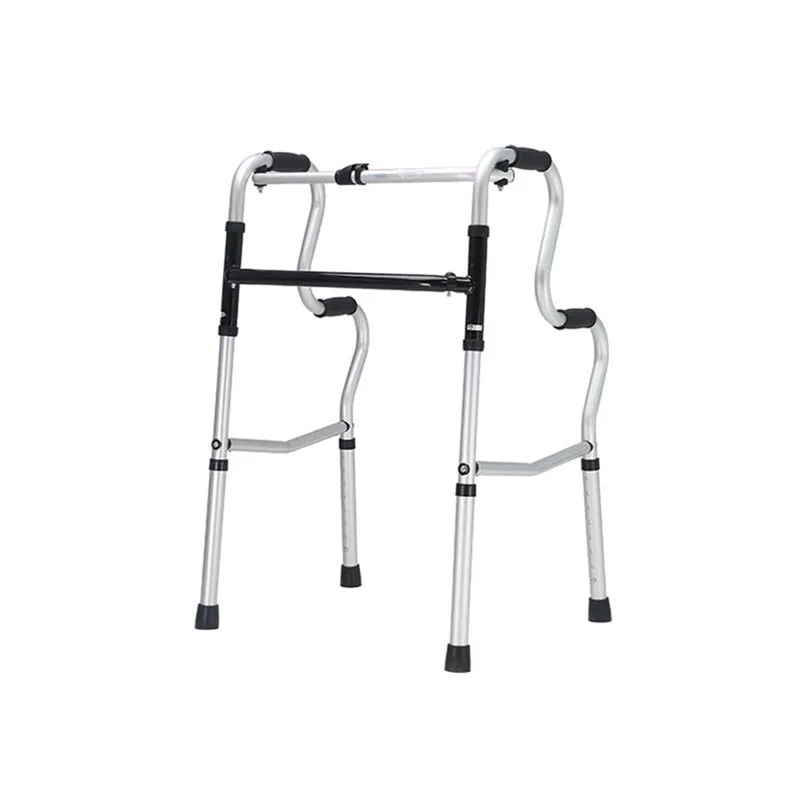As the most traditional and stable type of walker, a wheelless walking frame is widely used in hospital rehabilitation, home care, and postoperative rehabilitation settings due to its simple structure and large support area.
However, who should choose a wheelless walking frame? When should one switch to a wheeled walker or crutches? This article provides a systematic, practical, and professional overview covering its definition, working principles, and applicable population, aiming to help patients, families, and frontline caregivers make informed decisions.

What is a "wheelless walking frame"?
A wheelless walking frame refers to a four-legged metal or alloy frame walker with non-slip rubber tips at the ends of each leg. It lacks wheels, or only has wheels on the front two legs. The user must lift the entire frame and move it forward before taking steps. Compared to wheeled walkers (rollators) or two-wheeled front-wheeled walkers, wheelless walking frames provide a wider base of support and greater static stability. However, they require lifting the device to move, which requires more physical effort. Reputable health organizations categorize standard wheelless walking frames as mobility aids that provide the greatest stability.
What are the structures and working principles of wheelless walking frames?
A wheelless walking frame is typically made of lightweight metal (such as aluminum alloy or stainless steel). Its basic components include two upright posts, a lateral support bar, a handle, and four legs with non-slip pads. Some models are foldable for storage, while others have wider or reinforced "heavy-duty" designs for those who weigh more or require greater support.
• The working principle is simple: By expanding the base of support for the feet (or hands and feet) and transferring some of the upper body force to the device, a wheelless walking frame helps stabilize the user's center of gravity, distributes weight to the lower limbs, and reduces the risk of falls caused by momentary imbalance. Because it has no rolling parts, the device itself cannot slip due to inertia or uneven ground, resulting in superior static stability.

Why choose a wheelless walking frame?
Advantages of wheelless walking frames:
• Maximum static stability: For those who need more support, need to maintain a standing position, or need to transfer positions, a wheelless walking frame with four fixed legs provides the most reliable support.
• Simple structure and low failure rate: Compared to rollers with brakes and seats, wheelless walking frames are easier to maintain and have fewer points of failure.
• Suitable for short distances and confined indoor environments: In places like hallways and bathrooms at home or in healthcare facilities, fixed walking frames are easy to dock and place against walls.
Disadvantages of wheelless walking frames:
• Requires lifting equipment to move forward: Users must possess a certain level of upper limb strength and coordination; those with limited physical strength or arm strength may have difficulty using them long-term.
• Slow gait speed and high energy consumption: Continuous walking requires more effort than a wheeled walker; it is not suitable for long-distance outdoor walking. Some users have difficulty maneuvering around corners or navigating obstacles.
These advantages and disadvantages mean that wheelless walking frames are not a "one-size-fits-all" solution and should be selected based on individual functional abilities after a clinical assessment.

Who is a wheelless walking frame suitable for?
Regarding the question, "Who is it suitable for?" clinical and evidence-based research generally recommends wheelless walking frames for the following groups. It's important to emphasize that the final decision should be made by the clinical rehabilitation team (physical therapist/occupational therapist/attending physician) based on individual assessment.
Wheelless walking frames are suitable for the following groups:
1. Elderly individuals or patients with severe weight-bearing or gait instability
2. Individuals with weight-bearing limitations in their lower limbs
3. Individuals with adequate cognitive or neurological function but severe balance impairment
4. Individuals who need to move short distances indoors and have sufficient upper limb strength
1. Elderly individuals or patients with severe weight-bearing or gait instability
When individuals frequently experience swaying when standing or walking, or fear falling if they lose balance, wheelless walking frames provide a larger base, significantly improving a sense of security and stability when standing, rising, and walking short distances. A related review indicates that walker use is high among community-dwelling elderly people, and that the choice of different walker types is closely associated with fall risk. (National Center for Biotechnology Information,
2. Individuals with Lower Extremity Weight-Bearing Restrictions
During fracture or postoperative recovery, when some or all of the body weight needs to be distributed between the upper extremities and a walker (e.g., slow weight-bearing or partial weight-bearing), a wheelless walking frame can provide more stable load transfer, facilitating walking according to physician instructions. Physical therapy textbooks and nursing procedures emphasize the initial use of a fixed walking frame in these situations, transitioning to a wheeled walker as function recovers.
3. Individuals with moderate cognitive or neurological function but severe balance impairment
For some stroke rehabilitation patients, more stable support may be needed initially to train standing balance and gait patterns. Once gait is stable and upper extremity support is maintained, a wheeled walker or crutches can be considered. Literature suggests that different walkers may have different effects on fall type and environment, so the choice must be individualized.
4. Individuals with sufficient upper extremity strength and need to cover short distances indoors
In home care or hospital rehabilitation, many short-distance movements (from bedroom to bathroom, from bedside to chair) are more suitable for wheelless walkers. Wheelless walking frames are easy to lean against a wall, park, and provide good stability.
People who are not suitable for wheelless walking frames:
• People whose upper limb strength is insufficient to repeatedly lift a walking frame (such as some patients with advanced amyotrophic lateral sclerosis or severe joint disease).
• People who need to walk long distances outdoors or rest mid-walk (in these cases, a roller with wheels and a seat is often more suitable).
• People whose walking speed and safety are significantly affected by uneven roads or surfaces.

How to decide whether to purchase a wheelless walking frame?
The professional selection process is usually led by a rehabilitation department or physical therapist. Key assessment points include:
1. Gait and balance testing: Scales such as "One-legged Stand Time" and "TUG (Timed Up and Go)" are used to assess fall risk and dynamic balance ability.
2. Muscle strength assessment: Upper limb grip strength and shoulder and elbow strength are sufficient to support lifting the walking frame and maintain shoulder stability.
3. Assessment of daily activity needs: This includes travel distance, whether stairs are required, and home environment (door width, floor material).
4. Weight Permit and Weight Considerations: The physician will determine the patient's weight limit based on postoperative instructions or orthopedic requirements, and will select a more stable or larger walking frame accordingly.
5. Height and Handle Height Adjustment: The handlebars should be at the wrist crease when standing with your hands on the handles, or with your elbows bent approximately 15–30 degrees (common clinical recommendations are around 15 degrees or in the 15–30 degree range) to ensure shoulder relaxation and good force alignment during walking.
How to Properly Use a Wheelless Walking Frame? — (Practical Guide)
For patients using wheelless walking frames, nursing and rehabilitation education should include the following key points:
1. Height Adjustment: Stand in the walking frame with your shoulders relaxed and your elbows naturally bent approximately 15–30 degrees when holding the handles. Aligning the top of the handles with the wrist crease is also a convenient measurement.
2. Walking Steps: Align the walking frame with the handles. Lift the frame about half a step or one step, then lower it—stepping forward on your weaker side or foot first, then shifting your weight to the support in front of you—and repeat this sequence. Beginners should practice under the supervision of a physical therapist.
3. Going Up and Down Stairs: It is generally not recommended to use a wheelless walking frame to go up and down stairs alone. If necessary, seek assistance from another person or use a handrail, and employ proper walking techniques. Most rehabilitation guidelines recommend using a handrail or a caregiver for assistance when encountering stairs.
4. Floor and Environmental Considerations: Avoid slippery surfaces, carpet edges, or uneven surfaces; assess whether you can safely turn before entering or exiting narrow passages.
5. Fatigue Management: If walking long distances or moving frequently, consider using a wheeled and seated rollator or taking regular breaks to prevent fatigue and falls.
When to choose a wheelless, wheeled, or cane walker?
1. Wheelless Walking Frame vs. Wheeled Rollator
Wheelless Walking A wheeled frame provides greater static stability and is suitable for patients who require support or weight distribution. A roller aid offers excellent rolling performance, high speed, and typically includes a seat, making it suitable for those who need to walk long distances or take frequent breaks. Clinical reviews suggest that different types of walkers are associated with different fall events, and the choice should be based on individual function and circumstances.
2. Wheelless walking frame vs. cane
Crutches are suitable for users who only require minimal balance assistance or light unilateral support, while wheelless walking frames offer greater weight distribution and a larger base of support. If a patient can safely walk with a cane, a more cumbersome walking frame is usually unnecessary.
Wheelless walking frame: Maintenance, cleaning, and lifespan
1. Regularly inspect the rubber foot pads for wear and replace as necessary to prevent slippage.
2. Wipe aluminum alloy or stainless steel surfaces with a mild detergent; avoid immersion in water or strong acids or bases.
3. Adjustable pins and buttons should be kept clean and lubricated or tightened regularly.
4. Wheelless walking frames for general home use If properly maintained, the frame should last for years. Any signs of structural deformation or loose welds should be replaced immediately.
What mobility aids are best suited for elderly users?
For elderly patients, we recommend our adjustable walkers, foldable rollators, manual wheelchairs, and shower seats. Each model is ergonomically designed, tested for durability, and certified for safety. Our designs come with anti-slip grips, secure brakes, and lightweight frames.
We offer these products in bulk, with price quotes and wholesale deals suitable for care facilities or elderly care suppliers looking to buy direct from a certified Chinese factory.










